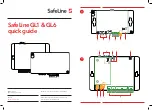Argent Data Systems
4 |
Setup
Before your Tracker4 is put into operation, some setup is required. Start by connecting the WiFi
antenna, GPS antenna, and a power source. The tracker may be powered through the rear DC
jack (a wall adapter may be purchased separately), the radio interface connector, the front
terminal block, or via USB.
Once the tracker is powered up, the initial configuration can be done through the web interface
or the command console. Both methods are detailed in their corresponding sections below.
Regardless of the method used, a few parameters need to be set.
Callsign
A callsign must be set before many of the tracker’s functions will operate. This callsign will usually
be the legal radio callsign of the tracker’s operator. A secondary station identifier (SSID) may be
used to distinguish multiple trackers with the same callsign. The SSID follows the callsign after a
dash and is a number from 0 to 15. The default SSID is 0, which is not displayed. For example, two
trackers operating under the callsign W1AW could be set with SSIDs of 1 and 2, which would be
represented as W1AW-1 and W1AW-2. W1AW alone is equivalent to W1AW-0.
Identification laws vary by country, but in most cases the callsign field is not required to be a legal
callsign as long as appropriate identification is provided somewhere and sent at appropriate
intervals. A common example is a tracker with a tactical callsign, for example ‘ROVER-1’, with the
legal callsign being reported in the comment field.
Setting the tracker’s callsign is not required for KISS mode. The KISS packets sent by the host
application will include their own callsign fields. The callsign must be set for the tracker to work in
standalone IGate mode, however, because gated packets include the gateway’s callsign.
Push-to-talk method
Some handheld radios don’t have a separate push-to-talk line and instead combine it with
the mic audio. For these radios, the HT PTT option must be enabled. See the radio interfacing
section of this manual for details


















